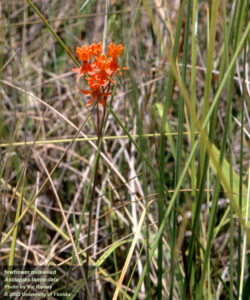
Asclepias spp.
More Info & Photos of Milkweed
Non-Herbicide Management Options
1. Physical Management Options
Milkweed can be cut and the rhizomes can be dug up. Physical control is difficult because it can re-establish from remaining seeds or rhizomes. Tillage of the soil in the area can be effective if it runs deep enough to destroy the roots.
2. Biological Management Options
At this time, there is no available biological control for milkweed.
Herbicide Control Options
Always read the product label for directions and precautions, as the label is the law. Click on the name of the product to see the label. Read the label for specific water use restrictions.
The active ingredients that have been successful in treating this plant include:
- Glyphosate
- 2,4-D
1) Glyphosate
Liquid glyphosate formulations have been effective on milkweed above the water line, but ineffective on plants in the water. They are broad spectrum, systemic herbicides. Systemic herbicides are absorbed and move within the plant to the site of action. Systemic herbicides tend to act more slowly than contact herbicides. An aquatically registered surfactant (see the label) will have to be added to the glyphosate solution for good results.
Common trade or product names include but are not limited to:
2) 2,4-D
2,4-D compounds are systemic herbicides. Systemic herbicides are absorbed and move within the plant to the site of action. Systemic herbicides tend to act more slowly than contact herbicides.
Common trade or product names include but are not limited to:
Precautions
One danger with any chemical control method is the chance of an oxygen depletion after the treatment caused by the decomposition of the dead plant material. Oxygen depletion can kill fish in the pond. If the pond is heavily infested with weeds, it may be possible (depending on the herbicide chosen) to treat the pond in sections and let each section decompose for about two weeks before treating another section. Aeration, particularly at night, for several days after treatment may help control the oxygen depletion.
One common problem in using aquatic herbicides is determining area and/or volume of the pond or area to be treated. To assist you with these determinations see SRAC #103 Calculating Area and Volume of Ponds and Tanks.
Many aquatically registered herbicides have water use restrictions (See General Water Use Restrictions).
To see the labels for these products click on the name. Always read and follow all label directions. Check label for specific water use restrictions.
Cultivation Options
Milkweed is often grown as an ornamental plant to attract monarch butterflies. This plant can be cultivated by planting seeds harvested from ripe pods or by cuttings. To start cuttings, cut the stems underwater, then coat the bottom of the stem with a strong rooting hormone. The stems should be placed in a substrate like sand or soil that is kept continuously moist and can usually be transplanted in 6-10 weeks. Survival is best when cuttings are made from green stems (1/3 inch diameter) Be sure to plant each variety in its preferred habitat, a variety suited to marshes would not thrive on a roadside and vice versa.
Questions?
If you need assistance, contact the Ag & Natural Resources agent in your county or hire a professional.